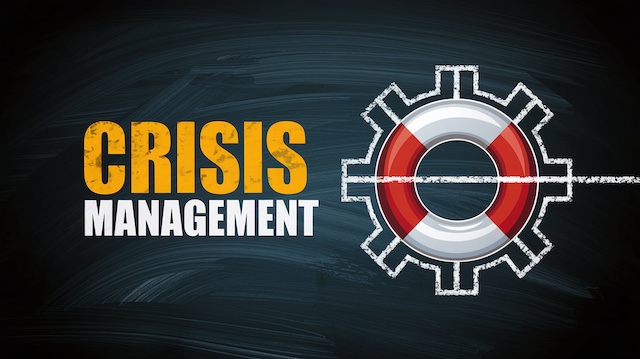A variety of unexpected crises can strike a business without warning. The company website crashes during a major product launch. A storm floods the office, leaving the team without a workspace. A leader must take an extended period away from work or leave altogether. These are the kinds of crises that can strike without warning, throwing even the best-run businesses into chaos.
That’s where a Crisis Management Plan (CMP) comes in.
A Crisis Management Plan is a strategy that defines how an organization will respond to critical situations that could negatively impact its operations, reputation, or financial stability.
As a leader, you know that things can still go sideways no matter how well you plan. A CMP gives you a roadmap for immediate action during a crisis, aiming to minimize damage and stress, protect stakeholders, and quickly restore normal operations for business continuity.
For example, let’s say a cybersecurity breach compromises sensitive customer data. A strong CMP ensures you’re ready to notify affected customers, address the issue with transparency, and work urgently to restore trust. Or, in the case of a sudden supply chain disruption, your CMP might include backup vendors or contingency plans to keep your operations running smoothly.
A CMP protects what matters most—your people, reputation, and bottom line. By anticipating potential risks and planning ahead, you can stay calm and focused under pressure so you are able to make informed decisions when they count.
What to Keep in Mind When Creating a Crisis Management Plan
Your crisis management plan should be a flexible, working document that your team can rely on and update as circumstances change. A well-structured plan often resembles a checklist, with the necessary steps so your team can respond effectively to any crisis.
- Conduct a thorough risk assessment: Identify and prioritize potential threats specific to your organization. This includes evaluating the risks your company might face—both the likelihood and potential impact of various crisis scenarios.
- Document criteria for crisis identification: Clearly define what constitutes a crisis for your organization.
- Assemble a crisis management team: Select individuals with diverse expertise to handle different aspects of a crisis. Define clear roles and responsibilities for each team member.
- Develop response strategies: Create detailed action plans for various crisis scenarios, with specific steps to be taken, resource allocation, and decision-making processes.
- Establish clear communication protocols: Designate authorized spokespersons and outline strategies for both internal and external communications during a crisis.
- Integrate with existing plans: Ensure your crisis management plan aligns with other emergency plans, such as business continuity and data recovery plans.
- Create monitoring systems: Implement early warning systems to detect potential crises before they escalate.
- Plan for business continuity: Outline procedures to maintain critical business functions during a crisis.
- Conduct regular training and simulations: Ensure your team is well-prepared by providing crisis management training and running practice scenarios.
- Establish review and update procedures: Regularly revisit and update your crisis management plan to keep it relevant and effective.
5 Steps of a Successful Crisis Management Plan
A successful crisis management plan is essential for organizations to effectively navigate and mitigate potential threats. Here are five crucial steps to create and implement a robust plan:
Step 1: Establish an early detection system
Implementing a comprehensive early warning system is critical for identifying potential crises before they escalate. This system should monitor various indicators across economic, social, and environmental factors.
Key components of an early warning system
1. Signal Detection: Identify relevant business signals that could indicate an emerging crisis. These may include:
- Performance metrics
- Customer satisfaction indicators
- Economic and market changes
- Operational anomalies
2. Monitoring mechanisms
- Continuous tracking of economic, social, and environmental factors
- Use of advanced sensors and analytical software
- Real-time data collection and interpretation
3. Established thresholds and triggers
- Define clear alert levels for different types of signals
- Create specific thresholds that prompt immediate action
- Develop a responsibility matrix for signal response
4. Technology integration
- Invest in reliable monitoring tools
- Upgrade IT systems to handle complex data flows
- Implement geographic information systems (GIS)
- Ensure robust communication networks
By tracking these diverse data points, organizations can detect subtle signs of emerging threats. Regularly assessing these indicators allows for proactive intervention, potentially preventing full-blown crises.

Step 2: Develop a comprehensive preparedness strategy
Once potential risks are identified, the next step is to create a detailed preparedness strategy. This involves conducting a complete risk assessment, prioritizing threats based on their likelihood and potential impact. Organizations should then develop specific action plans for various crisis scenarios, outlining precise steps, resource allocation, and decision-making processes.
It’s crucial to assemble a diverse crisis management team with representatives from different departments, including communications, legal, operations, IT, and HR, to ensure a well-rounded approach to crisis preparedness.
Step 3: Craft a robust communication framework
Effective communication is paramount during a crisis. Clear and consistent messaging helps maintain trust, mitigate rumors, and guide stakeholders through the situation. From the early warning stage to the post-crisis evaluation, timely and transparent communication can significantly impact the outcome of crisis management efforts.
Develop a clear communication strategy that outlines protocols for both internal and external stakeholders. Designate authorized spokespersons to deliver consistent messages during a crisis, ensuring that information is accurate and timely. The communication plan should address various internal and external channels—social media; press releases; email; departmental, all-staff, and board meetings; and intranet—to reach all relevant audiences efficiently.
Step 4: Implement and test response procedures
Creating detailed response procedures is essential for managing crises effectively. These procedures should cover containment strategies, stakeholder communication, and steps for restoring normal operations. Regularly conduct training sessions and realistic drills to test the effectiveness of your crisis management plan. These exercises help identify gaps in the plan and provide valuable experience for the crisis management team.
Step 5: Evaluate and refine the plan
Continuous evaluation and refinement is the final step in a successful crisis management plan. After each crisis or simulation, conduct a thorough assessment of the response efforts. Gather feedback from all involved parties and analyze the effectiveness of your strategies. Use these insights to update and improve your crisis management plan, ensuring it remains relevant and adaptive to new risks or organizational changes.
Crisis Management Examples
Workplace crises can strike at any time, and having a robust crisis management plan can make all the difference between quick recovery and prolonged chaos. Here are some scenarios where a CMP proves invaluable:
Cybersecurity Breach
A company’s customer database is hacked, exposing sensitive information. Without a CMP, employees might panic, and communication with stakeholders could be delayed or mishandled, further damaging the company’s reputation. With a CMP, the business can immediately implement a pre-established protocol: isolate affected systems, notify customers and regulators transparently, and deploy cybersecurity experts to contain the breach. A structured approach minimizes downtime, restores trust, and mitigates financial losses.
Natural Disaster
A manufacturing plant is severely damaged by a hurricane, halting production. Without a CMP, the business may scramble to assess the damage, communicate with employees, and coordinate insurance claims. With a CMP in place, however, emergency protocols would kick in: employee safety checks, pre-identified alternative production facilities, and clear communication to stakeholders to ensure that operations resume as quickly as possible.
Public Relations Crisis
A CEO’s controversial statement triggers backlash on social media. Without a CMP, responses may be inconsistent, compounding the issue. With a CMP, a pre-prepared crisis communications team would address the situation quickly, issuing a clear apology or statement, monitoring online sentiment, and implementing a plan to rebuild the company’s image.
Conclusion
A crisis management plan is a lifeline when things go wrong. For both individual employees and teams, a CMP brings much-needed clarity during stressful times. It ensures everyone knows their role, what steps to take, and how to work together effectively. This reduces panic, boosts confidence, and helps the team stay focused on solving the problem instead of being overwhelmed by it.
For the company, a CMP is a safety net that protects its people, reputation, and operations. It helps minimize risks, avoid unnecessary losses, and respond quickly to unexpected challenges like cyberattacks, natural disasters, or PR issues. Having a clear plan in place means the company can handle these situations smoothly, maintaining trust with customers and stakeholders.
INTOO offers workshops to help your team stay resilient during times of change and leadership training programs to ensure managers are up to the task of guiding their team members through a crisis. Contact us today to learn how we can be a part of your CMP.











